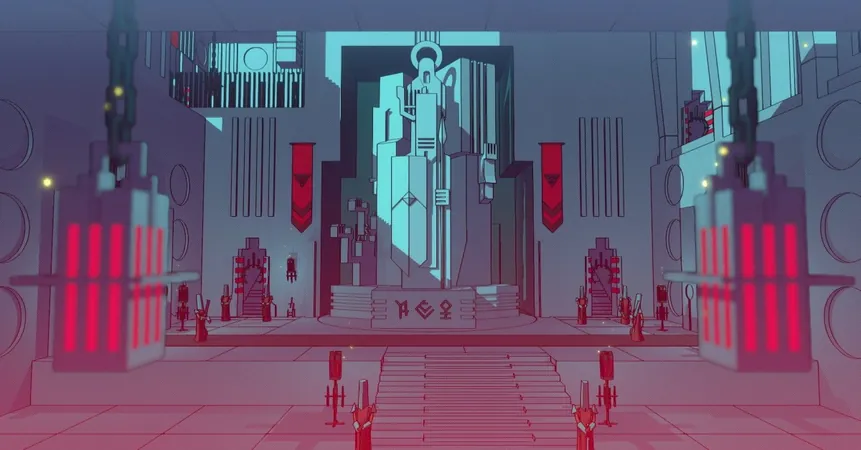
The Secret Sauce Behind Indie Games Finding Their First 1,000 Players
2025-01-12
Author: Noah
The Secret Sauce Behind Indie Games Finding Their First 1,000 Players
In today's bustling gaming landscape, one common enigma continues to puzzle both players and developers alike: how do newly launched indie games go from zero to thousands of players? While many attribute the success of breakout hits to popular streamers and YouTubers, a deeper look reveals that the platform itself can play a significant role—particularly on Steam, which boasts its own sophisticated discovery algorithms.
When a game is launched on Steam, developers have access to valuable metrics that allow them to understand user interactions, including how players found their game. These metrics indicate whether users clicked through from a link, stumbled upon the game through searches, or heard about it from friends or content creators. Steam serves not just as a virtual storefront but also as a powerful discovery engine through its various promotional features, like the Discovery Queue and 'More Like This' recommendations. Here’s the catch: developers cannot purchase ad space; they must earn their visibility through strong performance metrics, including favorable reviews and sustained player engagement.
Ryan Rigney, a marketing director in the gaming industry, points out that for his last project, ‘Omega Strikers’, over 70% of their page traffic originated from Steam’s promotional efforts. This emphasizes that while marketing efforts matter, the ability to engage players and generate revenue is essential for attracting the algorithm’s attention—thus paving the way for eventual breakout success.
Winning Hearts on Social Media: Loddlenaut Takes Off
One standout game is 'Loddlenaut', developed by Moon Lagoon, which centers around cleaning the ocean and nurturing aliens inspired by axolotls. According to co-founder Ricardo Escobar, the initial 1,000 sales largely stemmed from wishlist conversions on Steam, which peaked at 55,000 by launch. This impressive number can be attributed to both Steam's promotional events and TikTok virality. “Our participation in Steam’s ‘New & Trending’ tab helped catapult us into the audience's view, driving even more sales,” Escobar noted, reinforcing the importance of organic Steam traffic.
Chants of Sennaar: Timing Is Everything
French developers Rundisc followed up their modestly received game with 'Chants of Sennaar', an engaging puzzle game that sold hundreds of thousands of copies soon after its launch. Co-founder Julien Moya credited their strategy of releasing a demo version and the decision to debut just before the launch of the much-anticipated 'Starfield' RPG. “This positioning gave us unexpected visibility and set us up for success as we climbed the ‘Popular Upcoming’ list,” he explained. Moreover, strong reviews propelled their game forward once it launched, firmly establishing it in the public consciousness.
The Emotional Impact of Lil Gator Game
Meanwhile, 'Lil Gator Game' achieved swift momentum through a blend of traditional and emotional marketing strategies. Game Director Connor P. Quinn emphasized that while social media engagement and event participation were vital, it was the game's emotional resonance that truly captivated audiences. “When well-known streamers connected with the game emotionally, it drove a wave of new players,” Quinn insisted.
Nostalgia Meets Quality with SKALD: Against the Black Priory
Anders Lauridsen’s 'SKALD: Against the Black Priory', despite the odds against selling a retro pixel art RPG, also saw success. Lauridsen suggests that years of establishing a community through social media and targeted outreach formed a solid base for wishlist growth. Moreover, strategic partnerships with publishers and engaging trailers contributed to visibility and interest well before launch.
Key Takeaways for Aspiring Indie Developers
1. Build Anticipation: Utilize wishlists as a barometer for potential success. Secure enough pre-launch interest to climb Steam's promotional charts.
2. Engagement Channels: Actively engage with your target audience across platforms, making the most of social media.
3. Demo Versions: Consider offering a demo to gather feedback, generate interest, and create a buzz.
4. Emotional Appeal: Craft a game experience that resonates emotionally with players, encouraging them to share their experiences.
5. Understand Your Niche: Pinpoint your target market and market your game specifically to that audience.
The winding journey of indie game success is marked by creativity, strategy, and a pinch of luck. For those brave enough to dive in, the rewards can be as vast as the oceans of 'Loddlenaut'. With their aspirations set high, indie developers can apply these insights to find and engage their first 1,000 players—and maybe even much more!









 Brasil (PT)
Brasil (PT)
 Canada (EN)
Canada (EN)
 Chile (ES)
Chile (ES)
 Česko (CS)
Česko (CS)
 대한민국 (KO)
대한민국 (KO)
 España (ES)
España (ES)
 France (FR)
France (FR)
 Hong Kong (EN)
Hong Kong (EN)
 Italia (IT)
Italia (IT)
 日本 (JA)
日本 (JA)
 Magyarország (HU)
Magyarország (HU)
 Norge (NO)
Norge (NO)
 Polska (PL)
Polska (PL)
 Schweiz (DE)
Schweiz (DE)
 Singapore (EN)
Singapore (EN)
 Sverige (SV)
Sverige (SV)
 Suomi (FI)
Suomi (FI)
 Türkiye (TR)
Türkiye (TR)
 الإمارات العربية المتحدة (AR)
الإمارات العربية المتحدة (AR)